Study using multiple imaging methods reveals new features of telangiectasia
A combination of fluorescein and ICG angiography, retinal thickness analysis and OCT showed details previously unknown.
Click Here to Manage Email Alerts
TAORMINA, Italy — Fluorescein angiography (FA) and indocyamine green (ICG) angiography, retinal thickness analysis (RTA) and optical coherence tomography (OCT) disclose some prominent features of idiopathic juxtafoveal retinal telangiectasis (IJRT) that were previously unknown. At the Jules Gonin Club meeting here, Ricky Zolf, MD, presented the results of an imaging assessment of IJRT carried out at the Creteil University Eye Clinic, France.
IJRT were divided into the three main groups of Gass classification, according to clinical appearance and FA. Group 1A is visible and exudative IJRT, and group 1B is visible exudative and focal IJRT. Group 2A is occult and non-exudative IJRT, and group 2B is juvenile occult familial IJRT. Group 3A is occlusive IJRT, and group 3B is occlusive IJRT with CNS vasculopathy.
A total of 25 eyes in 15 patients presenting with type 1 and type 2 IJRT were examined. Besides complete ophthalmic examination, each patient underwent FA and ICG angiography, as well as RTA and OCT examination every 6 months. The follow-up period lasted for 18 months.
Group 1
A total of five patients (five eyes) presented with visible, exudative telangiectasis, and, therefore, belonged to group 1. They were all men between 40 and 50 years of age. “Only one eye of each patient presented the characteristic signs of IJRT, leading to mild to moderate loss of vision,” Dr. Zolf said.
Cystoid macular edema (CME) with hard exudates appeared as a prominent feature of type 1 IJRT. FA revealed early filling of telangiectatic vessels and late leakage into cystoid cavities.
Hyperfluorescent dots and a central hypofluorescent area were seen on ICG.
Large cystoid cavities were visible on OCT and appeared as a dome-shaped elevation in the retinal thickness maps of the RTA. Both RTA and OCT revealed that the retina was thicker than normal.
“In normal eyes, the retina is thinner at the fovea and thicker between the fovea and the disk. The average retinal thickness is 227 µm. In this group of IJRT eyes, the retinal shape was altered, and the average retinal thickness was more than 400 µm,” Dr. Zolf pointed out.
By the end of the 18 months of follow-up, no hard exudates were found. Three eyes showed persistence of CME, and two eyes showed the presence of atrophic tissue. FA revealed either an increased CME or a staining of atrophic tissue, indicating the presence of longstanding CME. The only change in ICG was a hyperfluorescent area of scar tissue in two eyes.
“In eyes with CME, RTA showed an enlargement of the dome-shaped elevation,” Dr. Zolf continued, “and the retina was still thicker than normal. In eyes without CME, the retina was either normal or thinner than normal (140 µm). On OCT, the persistence of cystoid cavities and a retina that was thicker than normal were observed in eyes with CME. In the two eyes without CME, no cystic cavities were visible, and the fovea presented a thinner central area.”
Group 2A
Group 2A consisted of seven women and three men who presented with bilateral occult, non-exudative IJRT. There are five different stages of development. The group 2A:
Stage 1 — No visible anomalies (none);
Stage 2 — Grayish perifoveal retina, few visible capillary telangiectasis, crystalline deposits (six eyes);
Stage 3 — Right-angle venules (20 eyes);
Stage 4 — Retinal pigment epithelium (RPE) hyperplasia (10 eyes); and
Stage 5 — CNV (one eye).
In all cases, FA showed an early filling of telangiectatic vessels in the perifoveal area and a mild, late leakage due to permeability changes in the outer retina.
On ICG, hyperfluorescent dots, a relative hypofluorescent area in the foveal center and retino-retinal anastomosis were visible in most cases.
“While the RTA showed that the retinal thickness was in the normal range (200 to 300 µm), the OCT showed some interesting features. One or more tiny retinal cavities were visible, and a red hyperreflection in the inner retina appeared in correspondence with the RPE hyperplasia,” Dr. Zolf said.
At 18 months, three of 20 eyes had developed CNV, and six of 20 eyes had developed focal atrophy. Lacy pattern leakage and staining of atrophic tissue were the only differences from baseline FA. On ICG, hyperfluorescence due either to CNV or atrophy was the only change from baseline.
RTA showed a normal or slightly increased retinal thickness. OCT showed no change from baseline.
“All imaging methods gave important, specific information, differentiating type 1 and type 2A IJRT. A more precise classification of morphological and clinical aspects of the two groups is now possible,” Dr. Zolf said.
As demonstrated, a combination of new techniques of investigation can give an exhaustive picture of telangiectasis, analyzing it from different points of view. However, some methods may be more helpful than others in specific cases.
“ICG, for example, is extremely important for the diagnosis and follow-up of both groups. In group 1, it should also be recommended as a guide for laser photocoagulation, as it visualizes telangiectasis better than FA. On the other hand, for group 2A in particular, OCT disclosed interesting morphologic aspects and gave better imaging information than RTA,” Dr. Zolf concluded.
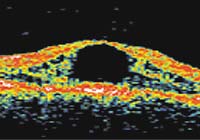 |  |
| An OCT image of group 1 IJRT showing a large cystoid cavity and a thick retina. | |
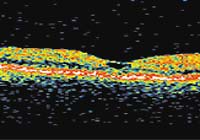 | 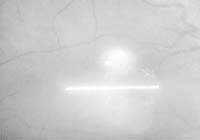 |
| An OCT image of group 2A IJRT showing a tiny intra-retinal cavity and a normal retinal thickness. | |
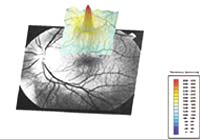 |  |
| RTA retinal thickness map showing a dome-shaped elevation and retina thicker than normal. | An OCT image of group 2A IJRT showing a red hyperreflection in the inner retina corresponding to RPE hyperplasia. |
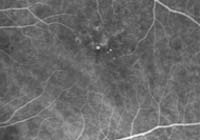 | 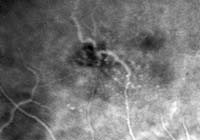 |
| ICG angiography showing hyperfluorescent dots corresponding to the visible telangiectasis of group 1 IJRT. | ICG angiography showing retino-retinal anastomosis (and probably retino-choroidal anastomosis) of group 2A IJRT. |
For Your Information:
- Ricky Zolf, MD, can be reached at P.O.B. 2175, Rishon-Lezion, Israel 75121; e- mail: r-zolf@zahav.net.il. Dr. Zolf has no direct financial interest in any of the products mentioned in this article, nor is he a paid consultant for any companies mentioned.
